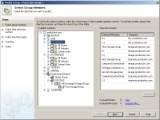Network server backup best practices: Backing up clustered servers
Backing up network servers can be tricky, especially if you're backing up clustered servers. Learn clustered server backup best practices in this tip.
Although backing up network servers is usually a fairly simple task, things can become confusing when it comes to backing up clustered servers. There isn't anything overly complicated about backing up a failover cluster. It's just that the rules of the game change when you start dealing with clusters, because clusters involve multiple physical servers (called nodes) that behave as one. In this article, I'll discuss failover cluster backups.
There are several different kinds of clusters, and each requires slightly different backup techniques. For the sake of demonstration, I'll describe how to back up a Windows Server Majority Node Set (MNS) cluster that is hosting Exchange Server 2007 in a Cluster Continuous Replication (CCR) configuration.
|
||||
When it comes to data backups, Microsoft recommends that you back up the passive node. The reasoning behind this recommendation is that the active node is doing all of the work, and backing up the passive node allows you to make a backup any time that you want without disrupting the users or consuming resources on the active node.
While this recommendation sounds logical enough, there is one tiny problem with it. In a failover situation, the passive node becomes the active node. When you bring the active node back online, it becomes the passive node, and remains the passive node unless you manually tell it to become the active node (or enable automatic fail back). So the problem becomes a matter of figuring out how to backup the passive node, when you can't be absolutely certain which node will be passive at any given moment.
Thankfully, you don't have to solve this puzzle all by yourself. Most enterprise-class data backup applications are cluster aware. Even so, you still have to use a bit of strategy when it comes to backing up cluster nodes.
To show you what I mean, take a look at "Figure A: Clustered backups" (click on image below for full size). This screen capture was taken from Microsoft's System Center Data Protection Manager 2007 (DPM 2007), which is the data backup application that I use on my own network. This particular dialog box allows you to select the objects that you want to back up. You will notice that there is a listing for a server named EXCHNODE1, and for another server named EXCHNODE2. These are the two nodes in my Exchange Server cluster.
Figure A: Clustered backups

As you can see, Microsoft's System Center Data Protection Manager 2007 lists each cluster node individually.
If you look toward the bottom of the list, you will notice a listing for ProdCluster. This is the name of the cluster that resides on the two cluster nodes. When I expand ProdCluster, DPM 2007 displays a listing for the cluster group, and for the clustered mailbox server.
DPM 2007 allows you to select the clustered mailbox server for backup independently of the two cluster nodes, but we still haven't done anything to target the passive node. However, when I select the clustered mailbox server and click Next, DPM 2007 displays the dialog box shown in "Figure B: Choosing which node to back up" (click on image below for full size). As you can see in the figure, I have the option of protecting a specific server, protecting the active node, or protecting the passive node.
Figure B: Choosing which node to back up
DPM 2007 allows you to choose which node you want to back up.
What should you back up?
So with all of these choices, you may be wondering what you should back up? Well, in my own organization, I chose to back up all of the volumes and the system state on the individual cluster nodes. That way, if a node fails, I can perform a restoration rather than having to manually rebuild the node. I also chose to back up the clustered mailbox server. In doing so, I am backing up the passive node. DPM 2007 also has an option to backup the active node if the passive node becomes unavailable. I chose this option so that I wouldn't be left without a backup in the event that my passive node fails.
In this article, I demonstrated some techniques for backing up a clustered mailbox server using DPM 2007. Although the options that I talked about are specific to DPM 2007, you will find that most enterprise-class backup applications offer similar options.
About the author: Brien M. Posey, MCSE, has previously received Microsoft's MVP award for Exchange Server, Windows Server and Internet Information Server (IIS). Brien has served as CIO for a nationwide chain of hospitals and was once responsible for the Department of Information Management at Fort Knox. You can visit Brien's personal website at www.brienposey.com.








